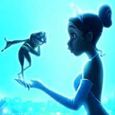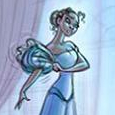Walt Disney Animation Studios (December 11 2009), Walt Disney Home Entertainment (March 16 2010), single BD plus DVD and Digital Copy disc, 97 mins plus supplements, 1080p high-definition 1.78:1 widescreen, DTS-HD 5.1 Master Audio, Rated G, Retail: $44.99
Storyboard:
The classic fairytale of The Frog Prince is turned inside out when, instead of the amphibian becoming human royalty when kissed, the spell is reversed and the girl becomes a frog as well! Soon she finds it’s not easy bein’ green, and the pair hop around the swamps of the New Orleans bayou attempting to put their fates right against the sinister Shadow Man, the voodoo master Dr Facilier…
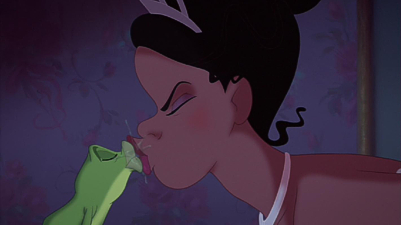
The Sweatbox Review:
There used to be a time when the Walt Disney Studios made fairytale movies. Walt Disney himself never made a “princess” movie…the stories that featured princes and princesses, friendly forest creatures and the other conventions typically associated with these types of films were strongly rooted in old folklore, mythical figures and, yes, fairytales. When Disney desperately needed a post-war hit, he only went back to the well to produce Cinderella because it could be fashioned into a similar success as Snow White, not because it simply featured another girl who becomes a princess. It could even be said that many of Walt’s films featured the fairy touch: certainly Pinocchio, moments in Fantasia, Peter Pan and Alice In Wonderland all share the same ethos of storytelling.
It’s also telling that, when the public’s fascination with such films couldn’t be counted upon, such as with Sleeping Beauty, that the Studio took off in a more contemporary direction, filling its films with upbeat songs and humor, and it took thirty years until the next generation of Disney artists really got back to the fairytale mix of magic and music with The Little Mermaid, in which Ariel was famously much more of her own character than the sometimes bland heroines that needed rescuing of before. She basically set in stone the very modern princess template that would carry through the next wave of fairytale type movies (Beauty And The Beast, Aladdin), and even the likes of Pocahontas and Mulan were set in far off ancient lands as to feel detached and mythical from our own world (the same can also be said for Hercules and Tarzan, too).
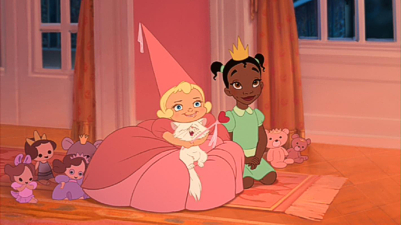
But with The Princess And The Frog, Disney has arguable made its first “princess movie”. Of course, Ariel started the merchandising trend of the “Disney Princess” brand, but so far that marketing angle hasn’t really influenced the making of the Studio’s animated movies: Belle, Jasmine, Pocahontas and Mulan all being shoehorned into the tradition that started with Snow White, Cinderella and Aurora. Since then the Princess brand has become a steady earner for the company, so how better than to mark its turnaround on a “no traditionally animated features” policy than to return to the fairytale well one more time – and add another face to the merchandising line up? Well, that’s just the underlying predicament with the film: is it actually a classic Disney fairytale as it wants you to believe, or is it a modern day “princess movie” with a capital P?

The answer, somewhat unfortunately, is the latter, and it shows right from the source material. The Frog Prince, as with so many of these stories, is a fairly lightweight, short plot, over in a matter of pages, so directors John Musker and Ron Clements – Disney veterans if ever there were ones and the duo responsible for Mermaid and Aladdin – have concocted up more of a lengthy story, based in part on The Frog Princess by E.D. Baker, a twist on the tale in which instead of finding herself a hunky royal dude when she kisses a frog, a girl transforms into one herself. Baker’s title is much more appropriate than Disney’s eventual moniker, not least because until the closing seconds of the film, the girl, Tiana, isn’t actually a princess at all, but I guess “The Girl Who Became A Princess…And The Frog” didn’t sound that catchy.

Naturally, more important than the wonky title is that this is not only Disney’s theatrical return to the hand drawn animation technique that made the company’s reputation after a near five-year hiatus, but has been advertised as featuring the Studio’s “first princess of color”. Perhaps being more specific might have helped: Tiana is certainly the first black heroine, but the first princess of color? Where does that leave Jasmine, Pocahontas or Mulan? Yes, one could suppose that this is a cultural step forward, coming as it does in the same year that America inaugurated its first black president (a mere coincidence, of course, being that such animated films take three to four years to create), but should this choice really be something to sing about when that color – for the most part of the movie, actually – is green and the filmmakers don’t look like they’re quite confident enough to go full on with an all-black lead couple?

It’s all these external topics that can make The Princess And The Frog hard to judge on its own merits. Yes, the return of traditionally animated Disney artistry on such a grand scale is enormously heartening, to put it mildly, and with Tiana at least the gates have been opened fully (if they weren’t pretty wide before anyway) to allow future heroines of all origins to feature prominently. The hype surrounding the release played heavily on over 75 years of such films that came before it, and the audiences’ love for those stories, and much was said about how it returned to the quality of the Disney Renaissance of the early 1990s, spearheaded by Ron ‘n’ John themselves, of course, and by the knockout Best Picture nominated Beauty And The Beast. That’s all quite some hype to live up to, though it unbalances what should be a very simple question: is it any good or not?
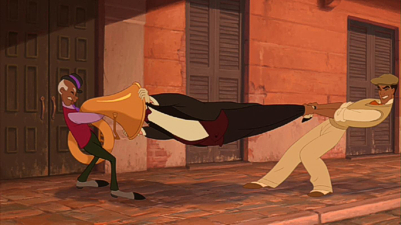
Well, removing all the baggage that surrounded the film’s theatrical release last November (traditionally a winning time for Disney films) and looking at the film as if it was simply the next out of the factory after 2004’s Home On The Range, the answer, as so many other critics have come to, is that while The Princess And The Frog is a pleasing return to classical animation on screen, it’s only a mildly diverting collection of nostalgic elements at best. The opening shots evoke memories of Lady And The Tramp in its production design, a clear inspiration that the filmmakers openly acknowledged. At a palatial mansion in deep south 1920s New Orleans, we find Tiana as a young girl, and her friend Charlotte, being told the fairytale story of The Frog Prince by her mother, a seamstress who is clearly under Charlotte’s family employ (quite how this relationship is any different to the one depicted between blacks and whites in the so-called “controversial”, but wonderful, Song Of The South must be over my head).
Tiana and her mother Eudora certainly don’t live in the affluent houses like Charlotte and her father Big Daddy (John Goodman voicing a character design that is highly unfortunate in its close resemblance to Range’s Alameda Slim), heading well out of town and home to the poorer areas which are nevertheless rich in warmth and love. Here, Tiana wishes upon a star in the hope her dream of opening a restaurant will someday come true and, quick as a flash, we leap a good few years later to where she is on the verge of having saved enough money to buy the property she envisions setting up shop (quite why supposed best friend Charlotte – now a svelte adult having lost her Darla Dimples – couldn’t help out isn’t explored either).
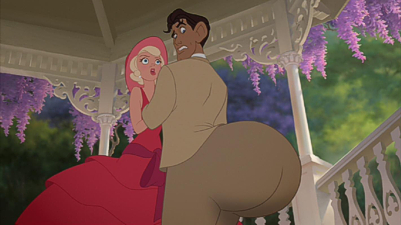
But all this happens rather quickly; the opening is more than a little rushed and somewhat “over animated”, as if the artists are really leaning on their pencils to impress and validate the return of this art form, rather than letting the result come over as relaxed and effortlessly confident. This over eager approach is mirrored in the somewhat oddly place Walt Disney Pictures logo, which flashes up on screen without a “Presents” attached and seems more like an enforced reminder that we’re watching A DISNEY MOVIE than anything else. The pride in showcasing this “badge of honor” is clear, but more understatement, as on Ron ‘n’ John’s other films, might have been preferable, and it just kind of hangs there on its own, with some time before the title then appears on screen.
We’re then quickly into the first of Randy Newman’s many songs, Down In New Orleans, a montage that packs in a lot of story points but is not as lean and economic as, say, the excellent opening plotting of Tarzan. Newman, a native of the area himself, and a genius at capturing the Midwest sensibility in music, oddly misses the mark here, capturing the New Orleans spirit more in his underscore than in the actual songs, which somewhat bland things out more than they should. Indeed, with Chris Montan in the producer’s chair, they could well be Alan Menken-composed pastiches if we didn’t know any better, but given cast vocals instead of Newman’s own, there’s only one or two that get anywhere near retaining the composer’s edge, even if you may well end up humming a few phrases over the next few days of listening.
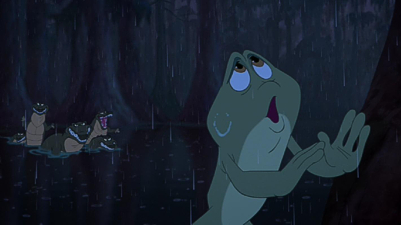
Visually, I had been worried from early previews that The Princess And The Frog might come over as a Disney wannabe, like many of the animated films that other studios rushed into production to compete against the Mouse House in the 1990s. There is a touch of that, but it’s all mostly saved by the sometimes excellent character animation (from a veteran who’s-who team all overjoyed to be working with pencils again) and the actual elements that feel “off” are mostly to do with the overly dense plotting: much happens in short spurts of time, but the film is well over the 90 minute mark and never really stops for a rest. The film’s timing, on a subconscious level, seems like everything happens too fast and too sharply.
There’s hardly any time to breathe at some points, such as the early slew of songs: short at around two minutes a piece, but we’ve three of ’em in under 15 minutes. The story’s villain, Dr Facilier, is an inspired creation, but even great as his Friends On The Other Side showstopper is, the storytelling is confusing, rushing through the plot’s lyrics and transforming our visiting royal dignitary hero Prince Naveen from charming to croaking before one can really keep up or understand why these things are happening. Indeed, Facilier’s overall plan is rather feeble for a Disney Villain, and though there are some sinister elements in play, he’s never actually in control of his fiendish “friends”, who would just as gleefully finish him off as any of the heroes. Friends On The Other Side has a good hook, and some fine visuals, but the forces of darkness don’t really come out in force and they never really make too much of an impact, certainly not enough to place Facilier in the pantheon of truly scary Disney badduns.
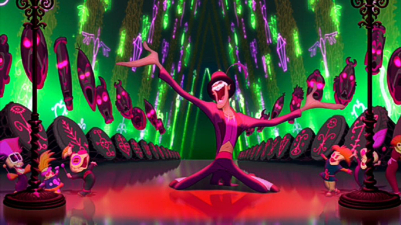
Things calm down and find a groove at the half hour mark, although it did strike me, given a moment to reflect, that all these whiz pop flashes, crashes and bangs might be a smokescreen themselves, an edict to the filmmakers to keep it “funny and loud” as an attempt to either conceal or apologise for the lack of CGI. There’s also a predictability to the structure: the plot and outcome is never in doubt, of course, but the songs, what they say, and where they come, are all too familiar – Naveen and Tiana’s “when we’re human again” song is especially by the numbers, even if it is jaunty enough and fun to be seeing such material on the screen again. And that’s just the film’s weak point: in trying to be something new with its setting and style, The Princess And The Frog’s basic elements revert to very safe formulaic defaults that long-time animation fans will be picking up on all over the place (I’m sure that some viewers will be disappointed that Louis the trumpet playing alligator isn’t voiced by Dom DeLuise, and as a similar aside, I kept hearing The Muppets’ Pepe the Prawn in Naveen’s performance).
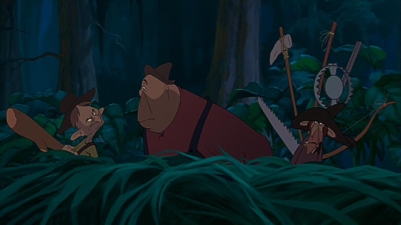
At 97 minutes the film is easily ten minutes longer than the average traditional Disney feature (even with close to ten minutes of credits). That can be no bad thing, of course, if the plotting can sustain it, but rather than be reminded of the strengths of the 1990s films, I was more surprised at recalling Disney films from a little earlier. I was astonished that a totally superfluous sequence with three stock-caricature rednecks out hunting frogs made it through to final animation without being cut very early into production – not only are the characters old hat and obvious, but the plot comes to an absolute standstill without any progression as a result. I was amazed at this point to find myself thinking that it felt more like a scene from the 1970s and ’80s features that have, in recent times, been said to include “great moments but a lack of narrative stretch” by the Studio’s management.
Well, not to put too fine a point on it, but that’s actually how the rest of The Princess And The Frog feels too, and at the 60 minute mark I again found myself wandering off and couldn’t believe that we were in for yet another song, once we met the nice but typically cracked voodoo lady Mama Odie, though for all the fast cutting and grand imagery, there seems to be a lack of scope and characters to fill the scene. And after this, with the ending in sight, there’s still a half hour to go. Unfortunately, if The Princess And The Frog’s box-office was a disappointment, it wasn’t because it had the word “Princess” in the title; it is sadly because the film just isn’t as smart, witty or sharply honed as the Studio’s effortless 1990s blend of top-notch technical aspects and self-assured storytelling.

It would be unfair to say that The Princess And The Frog is a failure; it is absolutely not in terms of entertainment, and it ticks all the boxes in so far as character designs and vocal performances, even if most are nothing too special and are totally satisfactory throughout. Plot strands and characters inevitably all come together in the final act, where Facilier tempts Tiana into betraying Naveen, and there are a couple of neat twists and the deaths of two characters that are quite emotionally rewarding. However, even here I had to question the need to bring one of the two back for a farewell scene: surely Facilier’s meanness would have been better illustrated leaving the character’s death as a swift and unexpected exit? Instead, having been presumably squished, they come back on their death bed, looking right as rain and without so much as a scratch.
These closing minutes also fall into the trap of fixing all previously explored problems when the spell is broken: here, Naveen and Tiana’s inevitable magic transformation back seems to blow all the cobwebs away, since not only does it make them human again but Naveen’s previously hinted at, and well hidden, money worries don’t seem to be an issue anymore, meaning Tiana’s restaurant can be open for business before the credits roll (leading to perhaps the funniest joke and certainly one that made me laugh out loud: the house band name of the Firefly Five Plus Lou).

The key talent involved in the production are all experienced veterans at this business, and with the Pixar Braintrust also noted in the long end scroll, one has to wonder why The Princess And The Frog just isn’t, simply, a better film. Perhaps it was a case of the artists not having picked up their pencils in too long, or that the subject matter was just outside Lasseter and company’s reach (it’s not for nothing that Pixar has yet to tackle a fairytale, or that their top level creators cite films such as Dumbo and Lady And The Tramp as their favorites over any of the classic fairytales). It also says a lot when something as flippant a pastiche as Enchanted came closer to replicating the authentic old-school Disney feel than a truly old-school endeavor like this could.
Ultimately, this film really needed to Wow. It wasn’t ever going to be enough to simply serve up a new Disney fairytale movie – especially one market geared towards the princess fans – it needed to be the Beauty And The Beast of our time. A film that not only returned Disney Animation to the forefront of the medium, but collectively reminded the industry and us audiences why it should have always been there in the first place. That was always going to be quite a weight on its shoulders, and while The Princess And The Frog never reaches anywhere near those ambitious goals, it is perfectly enchanting fare that does what it does well enough.
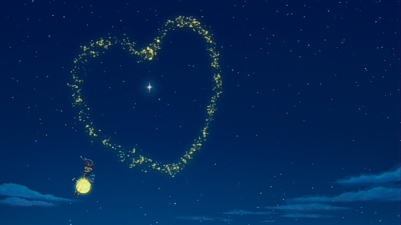
Is This Thing Loaded?
At first glance, one might think that, befitting such a landmark title, Disney has wisely decided to jettison the rather half-baked “special editions” of recent years and go full-out on a packed collection of extras like we used to know and love ’em. Well…sort of. This being the three-disc combo pack under review, the set consists of a single high-definition Blu-ray disc that’s more than capable of storing all the goodness that we once associated with the lavish two-disc DVD releases from the Studio, though the space isn’t always used to its full potential.
A string of Sneak Peeks are of course first on the agenda, and here we’re treated to glimpses of the Beauty And The Beast: Diamond Edition (seemingly back on track for a fall 2010 release after being rumored to be delayed following a 3D theatrical release), the Studio’s Rapunzel take Tangled (nameless on this teaser following the recent title change, even though others in the room shouted out “oh, it’s Rapunzel!”, and stupidly over complicated on the menu, where the entire tagline takes up much room instead of a simple title), Toy Storys 1, 2 and 3, plus a Disney combo pack spot. From the optional menu, additional spots for Old Dogs, James And The Giant Peach: Special Edition, Tinker Bell And The Great Fairy Rescue, Fantasia/Fantasia 2000: Diamond Edition and other generic promos can be selected, though true to form, Disney disables one of Blu-ray’s main bonuses and forces one to return to a menu screen as opposed to allowing pop-up options.

The wonderful thing about Blu-ray technology, and one of my favorite of the new features the format has provided, are the visual accompaniments to one of video disc’s oldest supplements: the audio commentary. Under various names (Disney choosing the most appropriate with Cine-Explore), these visualizations really go some way to creating a fully enveloping presentation on how a movie was carried from inception to completion. Unfortunately, Disney really drops the ball with The Princess And The Frog, bypassing any such elaborations in favor of a full-length Work In Progress version of the film. Now this may sound like something really cool – and it kind of is – but sadly this entire pencil test animation edition of the film has been shunted to the top right corner as the completed film fills up the rest of the screen, meaning everything that is of interest is often too small to appreciate at less than a quarter of the screen size. That this WIP version has also been edited to fit the final soundtrack and movie edition doesn’t really bring any further insight into the production process and, although those knowing what they’re looking at will pick up on the details, this comes over as something nice sounding but ultimately thrown in without much thought.
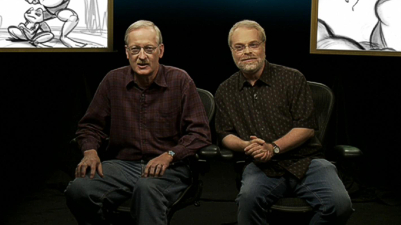
MUCH better, though frustrating, is the traditional filmmakers’ Audio Commentary with directors John Musker and Ron Clements and producer Peter Del Vecho: an excellent track well worth a listen to, but frustrating in that one can’t select it to play against the WIP version that might have combined to at least make the WIP more valuable. Alas, this is as basic as commentary tracks get technically, though Musker and Clements provide a lot of facts on their film that will either come as a great delight to newbies of such hand-drawn delights or as simply a bit of a nostalgic return to watching traditional animation accompanied by typically perceptive remarks. Everything from the original pitch (the directors silencing critics by asserting that a black heroine, 1920s New Orleans and Randy Newman songs were always part of the package) to the various stages of development are covered, and Musker especially provides a non-stop barrage of information.
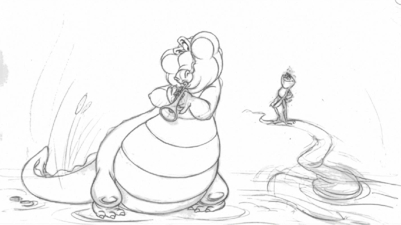
Ron ‘n’ John appear, somewhat self-consciously, onscreen for a series of four Deleted Scenes next, some of which are scene extensions or alterations. Already running long, it’s clear why most of these were cut (less so as to why the frog hunters remained though!) from the movie, but there are a couple of cute moments and fun gags (“He scares me…but not like I thought”) that might have played nicely in their original places. Taking care of more basics, a Never Knew I Needed music video written and performed by Ne-yo provides some typically slick visuals for the film’s end credit song, a slow-burn ballad and, like the movie, a bit of a throwback to the kinds of arrangements that would traditionally close the 1990s features. It’s catchy enough, and although there’s an alternate version of this video that includes animated clips from the movie, it’s actually refreshing to see a mini-story played out in under four minutes, and the 2.35:1 cinematography is well accomplished.
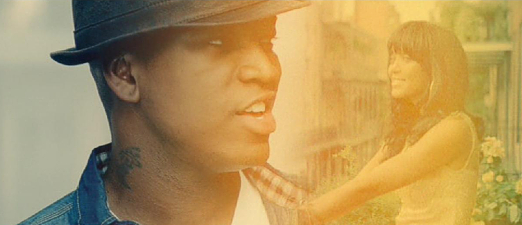
Bringing Animation To Life is a selection of three clips (an Introduction, Dig A Little Deeper and The Proposal) that offer something rarely seen on newer animated titles: a peek at the live-action reference footage shot for these scenes combined with rough storyboards and pencil tests. It’s clear, as the directors say in their intro, that these moments were not traced but, like the great Disney rotoscoping of old, used as a springboard for the animators to hop off from and create their resulting performances, and this is terrific stuff to witness. The rest of the production is explored in a number of promotional featurettes, the first of which is Magic In The Bayou: The Making Of A Princess.
Part look back on past Disney princesses and the return of traditional animation to the Studio, and part look forward at the development of the film, this is the most substantial look behind the scenes at 22 minutes. There’s naturally no mention of early versions or the controversy surrounding Tiana’s original name, Maddy, but we are rewarded instead with a good helping of talking heads from cast and crew, location footage of the visit to the Big Easy itself, and a welcome peek at the soundtrack’s music and vocals and animators that gives everyone their time to shine.
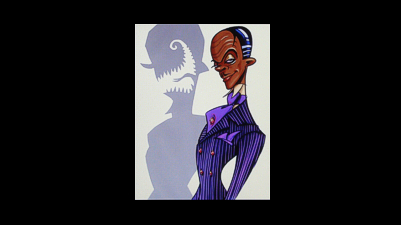
Next up, and while it’s neat to have an almost complete set of the online featurettes that promoted the film in the run up to release, it’s slightly disappointing that there isn’t really any “more” to the following clips, all of them pretty self explanatory from their titles: The Return To Hand Drawn Animation (2:43 mins), The Disney Legacy (2:31), Disney’s Newest Princess (2:51), The Princess And The Animator (2:26), Conjuring The Villain (1:48) and A Return To The Animated Musical (3:14).
A generous helping of Art Galleries provide a look at the Visual Development (including page mock-ups for newspapers, signs and The Frog Prince storybook), individual Character Designs, Layouts & Backgrounds, and Storyboard Art. All told, there’s some seriously gorgeous artwork here amongst the plentiful images, the only drawbacks being a lack of context on some of the more curious examples and, although presented on a neutral black backing, most are only presented at half or quarter screen sizes…when will they get the point that we want to be able to study this stuff!
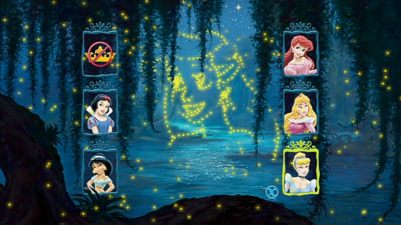
There’s really not much to the What Do You See: Princess Portraits game, for which the player must select which Disney princess is being “drawn” out by Ray’s firefly friends. Given the Blu-ray technology, it’s a shame that there’s nothing here that builds on basic DVD technology, and for a while I wondered what it was all leading to. Guess the right amount of princesses, and Mama Odie will reward you with quick re-cap versions of Disney’s past princesses’ stories, and although there’s no overt plug for the “Disney Princess” brand, it all feels a bit like the Studio is desperate to tie everything together. When the game option on the menu is selected, nudge the right arrow key for a very funny 45-second Easter Egg featuring a Chuck Jones inspired spoof on a “draw Naveen” spot, a nice way to end the disc (not counting the tagged-on Digital Copy promo).

All of the above supplements are pleasingly rendered in HD, and a handful of them have even made it over to the also included DVD in the pack. On this standard definition disc, you’ll find the movie in anamorphic widescreen, Musker and Clements’ audio commentary (but no Work In Progress overlay), the aforementioned four Deleted Scenes, and the Ne-yo music video. Bafflingly, none of the featurettes are available: someone obviously thinking it was more important to carry over the Princess Portraits game intact instead. Additionally, the entire feature film can be ported to your personal Windows Media or iTunes equipped player via the DisneyFile contained on the bonus Digital Copy disc, though again this is just standard definition and none of the extras are included.
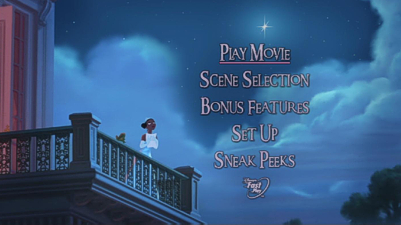
Since the set is so heavy on the promotional featurettes that played online in the run up to the theatrical release, it’s a surprise to find missing in action are any kind of more common publicity assets such as the various character posters or theatrical trailers, even if the film was heavily previewed on a lot of Disney disc product during the end of 2009. It might have also been neat to include the Vanessa Williams-hosted special that looked back on 75 years of Disney feature animation and heralded The Princess And The Frog’s return to the medium, and some of the character spots that popped up on television internationally. Or how about being brave and putting out Tiana’s animator Mark Henn’s directorial short John Henry, also thematically appealing to this title? That the disc does include a lot of material is one great thing; that it is made up of so much that is either half-baked or which big fans will have either already seen is disappointing.
Case Study:
Released in a single DVD, and single and triple-disc sets on Blu-ray, each edition comes with standard packaging native to their configuration. This particular edition is the BD plus DVD and Digital Copy three-disc collection, which basically packs everything into one box. Similar to previously released Disney combo packs such as Monsters, Inc. and Up, the thick Blu-ray case comes with a tray flap that holds the BD and DVD and the Digital Copy disc in the back of the case. Included are the Disney Rewards code and a booklet promoting a ton of upcoming titles, all housed in a glossy embossed slipcase that is actually the first to break away from Disney’s all-blue border coloring.
The sides are wraparounds from the back cover layout art, while the blue border (retained on the single-disc BD) has been swapped for a gold-like yellow even if this might have been a last minute switch: blue seems to have been the original color of choice if the slight blend around the rim of the front cover art is anything to go by. The cover isn’t anything too special, but once that border has been removed as on the sleeve underneath, it actually looks pretty enticing. As with many titles these days, the back is mostly taken up by the disc content listing and technical specifications, reducing any stills to token thumbnails. However, it all works and feels a bit magical just holding it in your hands.
Ink And Paint:
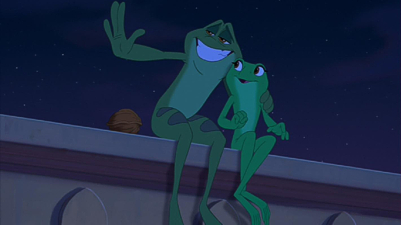
As with the soundtrack results commented upon below, image quality on a digitally produced (yes, even by hand!) feature film coming to an HD format less than six months after being completed is never going to be anything less than exemplary, and The Princess And The Frog certainly doesn’t disappoint. It may sound like phooey, but I did actually notice the subtle change from Disney’s own CAPS system to their using the industry-standard Toon Boom packages, the lines being ever so finer and the colors not quite as “deep” as on the previous tradigital films of the 1990s. Even so, there’s still a lot of color on show, and it’s all gorgeously rendered with far less banding than one got used to with DVD. The stand-out Dr Facilier sequence not only peps up the movie at that point but also provides a nice escape from all those blues and greens that otherwise dominate the visual tone!
Scratch Tracks:
Not for a long while have we been able to experience a lush, warm, animated Disney musical’s orchestrations, and it’s fair to say that this BD, and even the DVD, replicate the recordings with great texture. With home entertainment systems being the place that most tracks ultimately end up being played on, mixers are more than aware of the demands on their work to stand up against other films that may act as “wow” demo moments, and again it’s basically hard to fault any soundtrack coming to BD or DVD from any of the Hollywood majors these days. The music stands up as do the vocal performances, and although again there’s a predictability to the kind of experience we’re in for aurally, it’s active enough and provides a lot of fun here and there. Alternate 5.1 tracks are available across both discs including Descriptive English, French, Spanish and Portuguese, the same languages again available for the subtitles.
Final Cut:
I may have sounded overly negative in my main comments on the movie itself above, and by no means should readers take away from this review that I disliked The Princess And The Frog. In turns it is good entertainment and an enjoyable outing for the Studio, but strip away all the surrounding hoopla and it really is just a better than average production from the mouse factory. With all the pre-release hype mixed back in, it could easily be found to be more disappointing, as inoffensive an addition to the Disney canon as one could hope for, but not the film to restore an art form to its rightful home. The box office numbers tell their own story in this case: word of mouth simply wasn’t strong enough to beat off other competition, not least helped by Disney’s own dumping of multiple titles into cinemas in the same frame. However, it will have its fans and hopefully find more on home video: The Princess And The Frog deserves to be seen, and Disney’s sometimes uninspired disc treatment presents it with some short but sweet extras.
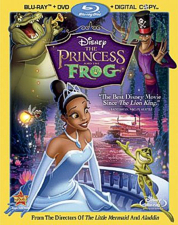 | ||
 |









